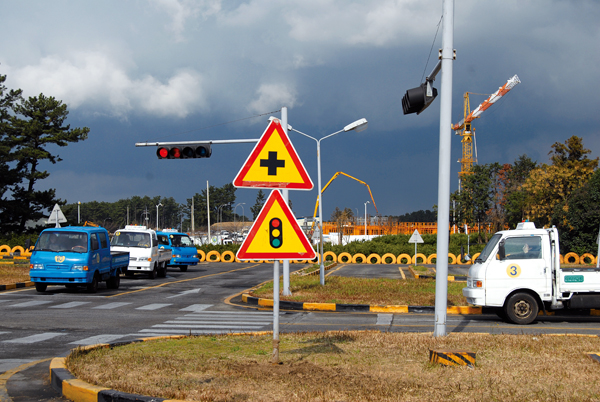| |
 |
|
| ▲ Modern systems, mercantile traditions. Photo by Justin Ferrell |
A Korean driver’s license is recognized in most provinces in China. And for about the same price as a domestic license, tourists can come to Korea, do some sightseeing, and then go home qualified to drive.
This is especially true for Jeju, one of only a handful of holiday destinations that have a visa-free policy for Chinese tourists.
According to Korea Bizwire, in 2010, sixty-eight Chinese citizens got a driver’s license in Jeju. In 2014, it was 991. That’s a 1,357 percent increase in only four years.
Apparently, however, “vacation licensing” has led to some intercultural friction. Chinese officials feel that easy Korean tests could lead to more accidents in China. They have even made a formal statement to the Korean government about their concerns.
According to that same Korea Bizwire article, Chinese media categorized the Korean on-road practical as so easy “even a blind person could pass it”.
Is this why the examination process is being upgraded at the end of 2016?
New questions will be added to the written exam in order to curb aggressive driving and to increase awareness about pedestrian safety. And the closed driving course will be expanded from 50 to 300 meters with a variety of new incline, turning, and intersection evaluations.
This is a reversal of changes made in 2011. Apparently too many people were failing, so, in a remarkable move, it was decided to just make the test easier. That’s when getting a Korean license started to become more internationally popular.
According to the Chosun Ilbo, 55 foreign nationals got their driver’s license in Korea in 2009. In 2014, that number was 4,949. The majority were Chinese.
However, the only real question here is whether or not people are being taught how to safely operate a motor vehicle - statistically the most insane form of transportation.
| |
 |
|
| ▲ How driving in Jeju feels sometimes Photo courtesy of PublicDomainPictures |
In the proud tradition of investigative journalism, The Jeju Weekly sent their fifth best reporter to explore the seedy underbelly of the Korean DMV.
To be honest, my first visit to the Driver’s License Examination Office wasn’t seedy in the least. It was, however, incredibly crowded.
People were squirting out the sides of the large reception area like ricotta cheese from overstuffed ravioli. Actually, I guess dim sum would be a more ethnically precise simile since there was, in fact, a great deal of Chinese being spoken.
After an enormous amount of waiting, lots of paperwork, and ₩25,000, I was sent upstairs to begin.
My thumbprint was scanned. I sat down in an ugly little room with fifteen other people. The hour-long traffic safety educational video started.
From its low production value, I assumed this video was an homage to late night infomercials. And I don't think the Chinese subtitles really helped much since nobody was watching anyway.
A young official came back into the room when it ended. She scanned everyone’s thumbprint a second time. It was a strange and Orwellian way to prove that we had been present for the first and last thirty seconds of this video.
Apparently I now had a working knowledge of Korean traffic safety, so I went downstairs to have my head examined. I paid ₩6,000 for a whirlwind vision test, which - if nothing else - proved I wasn’t blind.
After more paperwork, more waiting, and more money, I was deemed ready for the written test.
The look and feel of this computer-based exam felt inspired by the Atari 2600. The questions were poorly translated and enigmatic. Even when the English was comprehensible, many of the answers were not.
For instance, when involved in a traffic accident, what should you do first to check the consciousness of the injured?
A. Check their pulse.
B. Lightly shake their shoulders.
C. Apply pressure to any wound bleeding heavily.
D. Check if anything is blocking their airway.
The answer was B, but what does aggravating someone’s concussion have to do with getting a driver's license? And shouldn’t I stop the bleeding first?
I giggled when my score flashed on the screen. I had answered 72 percent of the questions correctly without understanding 80 percent of them.
It was basically the same experience throughout each component of the licensing process: wait a lot, pay money, then guess how to pass the test.
It took me 4 weeks and ₩93,000 to finally get my license.
I learned that the test was easy in all the wrong ways and difficult in all the worst ways. I think it actually degraded my understanding of what it means to be an effective driver.
The closed course test, for example, was fifty useless meters of inexplicable computer commands. I’m still not sure why I passed.
And the on-road driving practical was nothing less than oxymoronic. I honestly didn’t know if I was supposed to follow the rules of the road or just drive like everyone else. Because let’s face it, for most people driving is just a distraction from their smartphone.
All of which leads me to the thesis of my investigation: These tests have little to do with how people actually drive.
To the understaffed, overworked people who administer the tests, this truth is self-evident. Nothing highlighted this more than the on-road practical.
By following the rules for speed limits, u-turns, stop signs, lane changes, and pedestrian crosswalks, the test vehicle actually became a menace.
People were honking, zooming past me, and hitting their brakes the entire time I was taking the practical because I simply wasn’t following the normal flow of traffic.
Hopefully the upgrades will address these troubling issues. It would be nice if authentic mastery and safety became the main focus. However, I doubt it will.
Unfortunately, this seems to have less to do with driving or nationality than it does about money. Our modern systems still follow ancient mercantile traditions. And despite the dangers, I suspect that people will continue to use these well worn trade routes for as long as there is profit to be made.
If you enjoyed this article, make sure to see The Jeju Weekly's "Getting a Korean driver's license" and "International driver's licenses and exchanging your license" for a more detailed look into getting a license here in Korea!
| |
 |
|
| ▲ The closed course test Photo courtesy of The Jeju Weekly Collection |
|






















